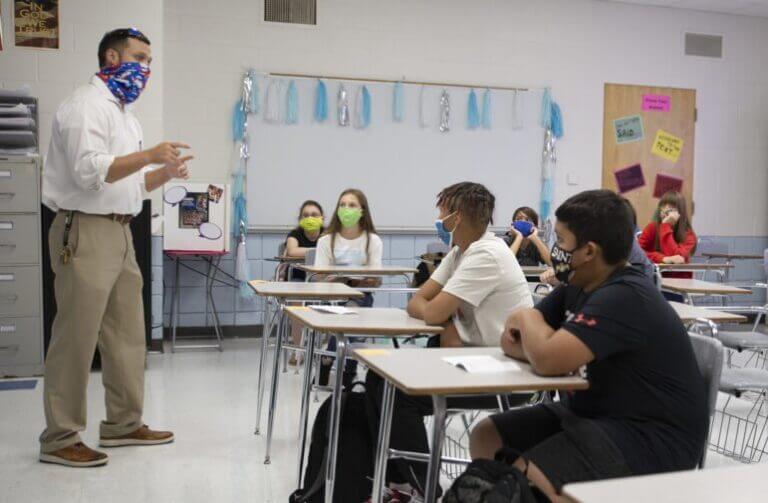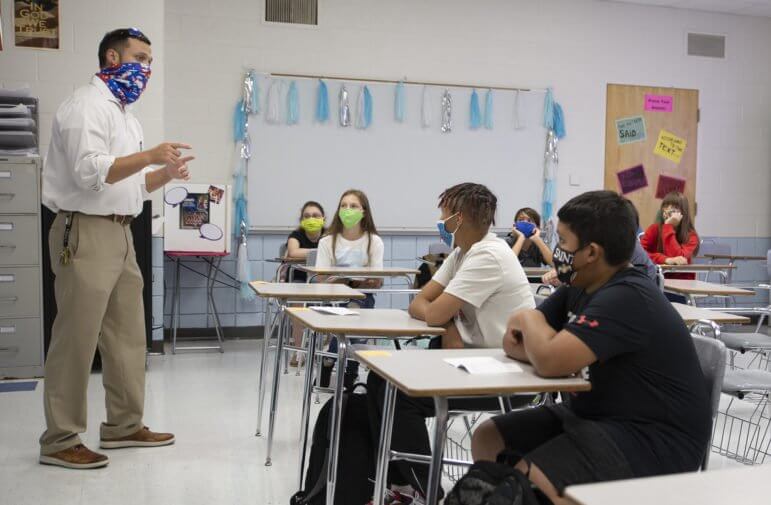

Eric J. Shelton/Mississippi Today
Cody Killen, Neshoba Central Middle School Principal, talks to an English class on the day of school on Wednesday, August 5, 2020 in Philadelphia, Miss.
Schools across the state saw massive drops in student attendance in the fall semester, and more than half of Mississippi school districts appealed to the state superintendent of education with concerns about their funding as a result.
School districts are funded based on a calculation known as average daily attendance. This figure is a snapshot of attendance for the school year taken by averaging daily attendance for the second and third months of the academic year. Students must be present for at least 63% of a school day or they are marked absent.
While enrollment in public schools decreased around 23,000 students from last year to this year, absenteeism among enrolled students was on the rise due to quarantining, positive COVID-19 infections and connectivity issues.
READ MORE: State Superintendent Carey Wright discusses where 23,000 students went this year
Though the total amount schools stand to lose is unclear, superintendents from 80 school districts asked Carey Wright, the state superintendent of education, to consider whether their funding can be adjusted based on an “inordinately large number of absences” as the result of an epidemic or natural disaster.
Carla Evers, superintendent of Pass Christian School District, detailed widespread attendance issues in an email to Wright on Nov. 30 appealing for an adjusted funding amount based on a provision in state law. She said despite the fact that nearly 90% of students are learning in person, absences are high due to quarantining and infections.
“Both virtual and in-person students and parents are finding it difficult to balance this new set of circumstances. With parents faced with the difficult choice of keeping their children at home and the need to return to work, children are often left to their own devices during the day,” she wrote. “This COVID-related phenomenon has resulted in unprecedented attendance issues in our schools with some days being in the low 80% range.”
The district usually has strong attendance rates — above 95% — and very low chronic absenteeism, which is defined as missing more than 10% or more of school days and is linked to poor outcomes such as falling behind academically and a lower chance of graduating from high school.
“Currently, 29% of students have 5 or more absences with 11% having already met the threshold for chronic absenteeism” as of Nov. 30, she said.
A rule under the Mississippi Adequate Education Program, the law used to determine public school funding, provides a complicated formula to determine whether a district has experienced an “inordinately large number of absences.” If it has, the district can receive funds based on the prior year’s average daily attendance figure.
Specific figures are unclear, but many districts would stand to lose a substantial amount of money if numbers from this year are used — one reason why Wright is asking the Legislature to consider an alternative approach to calculating average daily attendance.
“There is a lot of concern, and rightfully so, from state superintendents about the children they’ve lost, but we fully expect those children to return once we get past the vaccination and the issues around the pandemic,” she told members of the Senate Education Committee at a hearing on Wednesday.
Jackson County School District Superintendent John Strycker said if the actual numbers for this year were used to fund his district next year, it would result in a loss of around $900,000, or the equivalent of 14 teacher positions.
The district’s overall enrollment is also down 5% due to students’ transition to home school, private school or moving elsewhere.
“If funding were cut (this year) we’d be hit twice — lower funding in a year with an expected increase in students because of kindergartners delaying entry and homeschooled (students) returning to school,” he said.
Enterprise School District Superintendent Josh Perkins described the attendance issue in his schools in his appeal to Wright.
Despite operating in a traditional, in-person format all semester, COVID-19 infections and exposure among students and family members has led to an increase in absences.
“Being a rural school district, the quarantining of students with connectivity issues for 14 days had lead to a decrease in attendance and engagement from those individuals,” Perkins wrote in a Nov. 20 letter.
Perkins said students who have elected to learn virtually full-time are “struggling academically and failing to participate in the daily lessons. Due to this, these students are being marked absent, which significantly lowers our average daily attendance.”
At the legislative meeting this week, Wright presented three different funding scenarios to lawmakers but recommended they use a three-year average of average daily attendance spanning 2018-19 through 2020-21 to fund schools this year.
“This takes into account the ups and downs over a period of time,” she told lawmakers. “That being said, I would love for us to have a discussion about moving away from (average daily attendance) to average daily membership,” or the use of enrollment to determine funding. “Schools still have to accommodate the kids that have registered and have to pay the teachers for that number of children.”
The post Declining enrollment, increased absences threaten public school funding appeared first on Mississippi Today.
- Ole Miss QB Trinidad Chambliss sues NCAA to seek extra year of eligibility - January 16, 2026
- Growing up Jewish in Mississippi: Optimism and hope amid the hate - January 16, 2026
- At Jackson prayer service, people of many faiths support Beth Israel after synagogue arson - January 16, 2026